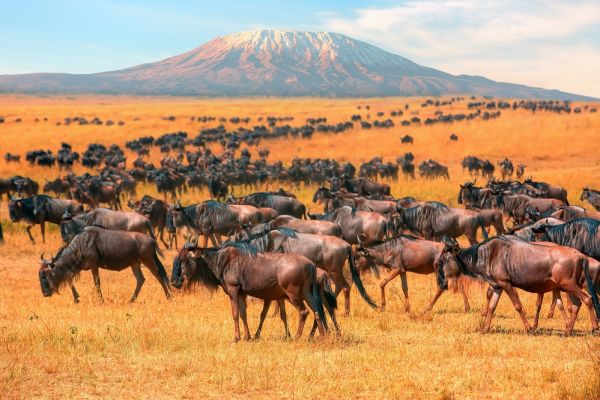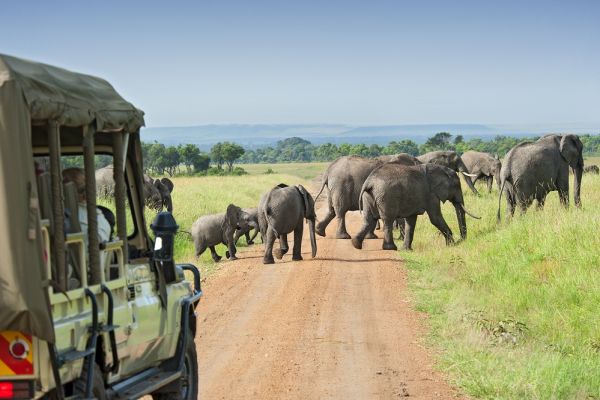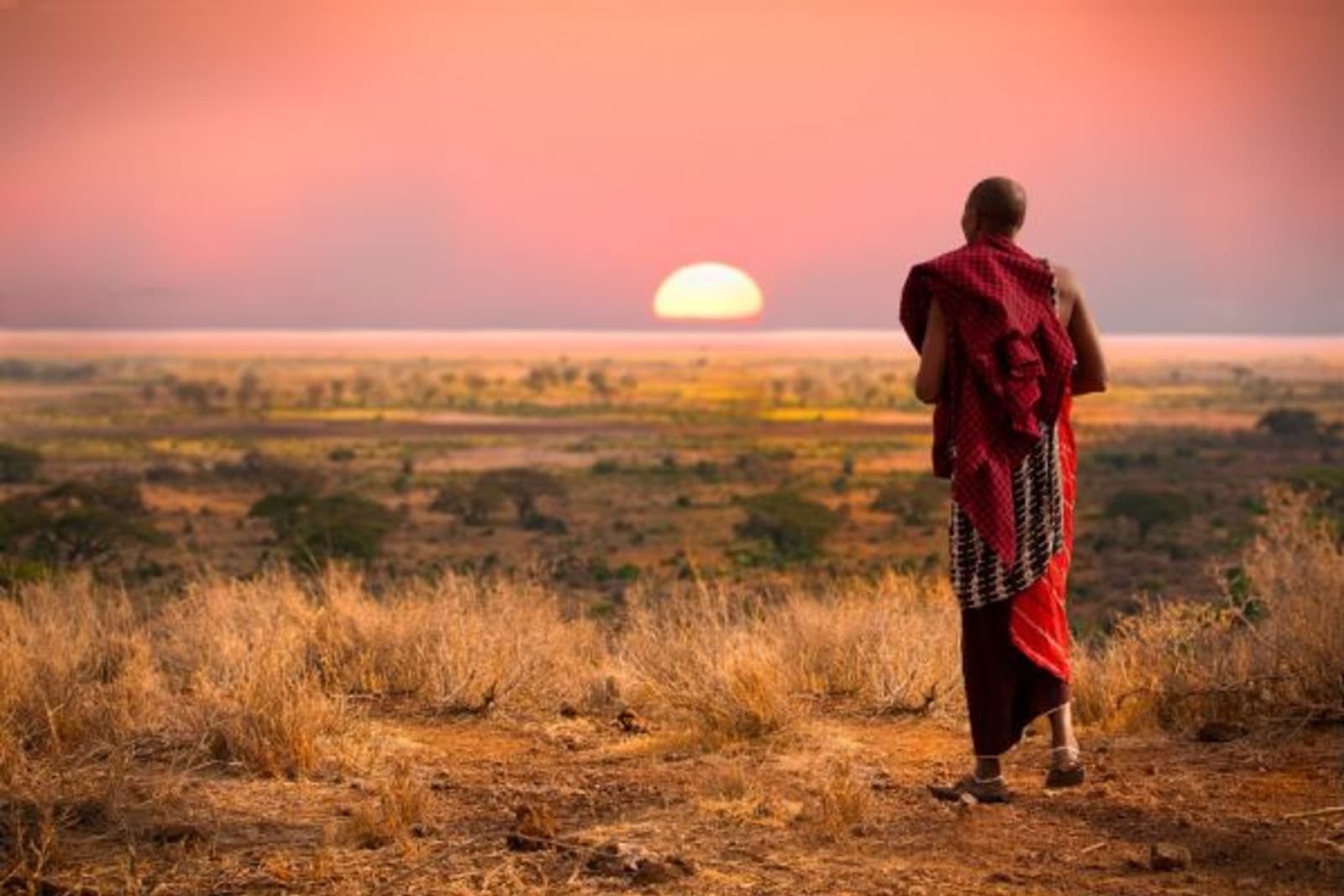TanzaniaTravel Guide
From the snow-capped summit of Mount Kilimanjaro to the palm-fringed beaches of Zanzibar, Tanzania does not disappoint. As the largest country in East Africa, it packs a mighty punch, with plenty for travellers to experience aside from migrating wildebeest.
Peel back the layers and you’ll soon discover a nation steeped in culture. More than anything, it’s the people who will make your visit memorable, so start practising your Swahili – ‘jambo’ (hello)! This Tanzania Travel Guide is a good place to start, but be willing to look beyond your safari experience, and you’re bound to discover her real magic. It is said that in Tanzania the best journeys begin at the end of your comfort zone, and we couldn’t agree more.
Explore Tanzania
Where to stay in Tanzania?
Wondering about where to stay in Tanzania? From luxury lodges to pared-back camps and comfortable hotels, it really all depends on what you want and need:
Seeking a refined safari experience? Snap up a stay at the Honeyguide Tarangire Camp. Quietly tucked away in Tarangire National Park, it ticks all the right boxes for travellers with a little more room in their budget. Sure, it comes with the price tag, but just picture it: spacious Livingstone tents and a front-row seat to the game-rich savanna – yes, please!
Whether you’re dropping into Dar for several nights or just one, don’t overlook the Sea Cliff Hotel. It’s got everything you need, including shuttle transfers to and from Julius Nyerere International Airport. Perched on a cliff overlooking the Indian Ocean, you’ll get the best of both city and sea.
Clear away all the safari dust with a few nights at the Park Hyatt Zanzibar. This resort-style accommodation comprises two separate buildings, giving you even greater choice on where to bed down. With the ocean right on your doorstep, Park Hyatt is the top choice when it comes to beach holidays in Tanzania.
If you’re heading to Tanzania for the wildlife, make a beeline for the Ikoma Tented Camp. Since it’s located just outside the Serengeti’s gates, it’s more affordable for less cash-flush visitors. Comfortable and welcoming, this safari camp hits the sweet spot for those who can do without all the extra bells and whistles.
Believe us when we say, this is just the start. Book your Tanzania accommodation today!
Things to do in Tanzania
You’ll find no shortage of things to do in Tanzania, but if you’re not sure where to start, here’s what we suggest:
No visit to Tanzania would be complete without experiencing the Great Migration. During this spectacular wildlife show, well over two million wildebeests and zebras shake the earth as they charge across the Serengeti National Park in search of nutrient-rich grasslands. The migration depends on available grazing, water and the weather, but generally starts in July and continues until mid-October.
Dar es Salaam (or simply Dar) is much more than just a stopover for safari-aficionados heading into the bush. Brimming with culture and eclectic contrasts, there is plenty to see and do if you’re willing to dive in. Despite its bustling markets and tizzy of tuk tuks (bajaji), it has somehow managed to retain a pretty relaxed and laid-back vibe.
Africa’s highest peak at 5,895 metres, Mount Kilimanjaro also deserves a mention. While you can touch ‘the roof of Africa’ by climbing it, Kili can also be admired and appreciated from down on the ground within the Serengeti National Park, and Ngorongoro Conservation Area.
When you’re ready to wiggle your toes in the white sand, head across to Zanzibar. This shimmering archipelago off the coast of Tanzania is fondly known as the ‘Spice Island’, showcasing African, Arabic and eastern influences. The UNESCO-listed Stone Town is a bustling cultural treasure where you can tuck into tasty cuisine and visit the house Freddie Mercury grew up in.
Lake Manyara is easily one of the loveliest lakes in Africa. Situated in Manyara National Park and bordered by the Great Rift Valley, this glittering pool is just the place to witness flocks of pretty pink flamingos. Twitchers, assemble! While out on game drives, do keep an eye out for those famous tree-climbing lions – it’s a thing in these parts.
Looking for an immersive experience? Then a Tanzania tour is the way to go.
Tanzania food and drink
Wondering where to eat in Tanzania? If you’re going on safari, your lodge or tented camp will have this part covered, but here’s what we recommend in Zanzibar and Dar:
One thing Tanzania’s iconic Spice Island has no shortage of is restaurants and sundowner hot spots. If ambience and location top your list, wind down at The Rock Restaurant. Settled atop a rocky outcrop on Michanwi Pingwe beach, this quirky eatery can only be accessed by foot at low tide or boat at high tide.
If you’re in the mood for something a little fancier, suit up and amble over to Emerson on Hurumzi with its stellar views over Stone Town and fresh seafood selection.
In the mood for authentic street food? Prepare to be spoilt for choice at Kariakoo Market in Dar es Salaam. This is just the spot to sink your teeth into a wide range of traditional Tanzanian favourites including nyama choma (barbecued meat), and ugali, a type of porridge made from cornmeal.
Mamboz Corner BBQ also offers a wide selection of mouth-watering fare cooked to perfection on the barbeque.
Get a real taste for the local cuisine by booking a Tanzania tour.
Where to shop in Tanzania?
In Tanzania, the main hubs of Dar es Salaam, Stone Town (Zanzibar) and Arusha offer travellers opportunities to fill their bags with sustainable treasures. Here’s exactly where all the best shopping in Tanzania takes centre stage:
With its bounty of glitzy malls and craft stores, downtown Dar is a filled with shopping options. If you can handle the bustle of big crowds, head to Kariakoo. Spanning several blocks, this sprawling market offers everything (and we mean everything!) from clothes, cosmetics and toys to fresh fruit and veg.
For thoughtful and bespoke wooden handicrafts, head to the Mwenge Carvers’ Village on the outskirts of town. Tingatinga Arts Cooperative Society in Haile Selassie Road also tops the list should you like to return home with your very own tinga-tinga art piece.
Should you want to treat yourself to some tanzanite, The Tanzanite Experience in Arusha is the prime place to snap up this semi-precious gemstone. Since they can only be found in Tanzania’s Kili foothills, now’s your chance.
As for souvenir shopping during your safari experience, the city of Arusha has its fair share of local markets. Maasai Market Curios and Crafts is the place to go for shuka – vibrant checkered shawls proudly worn by the Maasai.
Over in Zanzibar, the souks and tangled alleyways in Stone Town are fun to amble through, while most beach resorts have dedicated stalls where you can pick up last-minute goodies. With a broad selection of jewellry, candles, soap and handmade wares, the Cultural Arts Centre Zanzibar offers a refreshing change from the overly abundant wooden crafts found throughout the island.
Memories of Zanzibar also boasts a plethora of memorabilia – books, kikoys (shawls), sandals, furniture, leather goods – you name it.
When is the best time to travel to Tanzania?
Wondering about the best time to travel in Tanzania? When it comes to Zanzibar, it’s year-round, but here’s a basic outline of what to expect elsewhere:
In a nutshell, the best time to visit Tanzania is from July to October when the country is driest and game viewing reaches its pinnacle. This also coincides with the Great Migration river crossings, when mega herds of beesties make their way across the Grumeti River in search of fresh grasslands.
Tanzania’s low season, also referred to as the ‘green season’, occurs between November and March. Although rain showers are more common during this time (the short rains), game viewing is still good with less khaki-clad tourists to compete with. Temperatures can peak at 40 degrees Celsius (104 degrees Fahrenheit) at this time. The arrival of migratory birds during this time makes it perfect for birdwatching in destinations like Ruaha and Tarangire.
March to May temperatures often exceed 30 degrees Celsius (86 degrees Fahrenheit) and the only time we’d recommend travellers avoid Tanzania is between April and May, when heavy rains (the long rains) can disrupt your game-viewing experience. Bookmark the months of January and February should you want to witness calves being born – just be aware that high-season prices may apply.
Don't miss out. Book your Tanzania flight today!
How to get around Tanzania
Here’s everything there is to know about getting around in Tanzania:
Roads close to major cities like Dar and popular destinations such as the Serengeti, Ngorongoro Crater, and Kilimanjaro National Park are well maintained. However, the further away you venture the more hair-raising it becomes.
On a budget? Although quite slow, buses are an economical option between major cities and towns. Within these hubs, Ubers, taxis, dalla dalla (minibuses), boda boda (motorcycle taxis), and bajaji (tuk tuks) are the way to go.
Local boat ferries link various towns along Lake Victoria and Lake Tanganyika, as well as all the coastal islands. Azam Marine forms one of several companies operating between Dar es Salaam and Zanzibar.
Despite being pricier, most travellers seeking a safari experience opt to go by charter plane, especially when accessing remote lodges and tented camps in the country’s national parks. Tanzania boasts three international airports: Julius Nyerere International Airport in Dar es Salaam, Kilimanjaro International Airport between Moshi and Arusha, and Abeid Amani in Zanzibar.
Let us help you organise your own wheels for exploring. Hire a car in Tanzania today!
What are the best beaches in Tanzania?
Pack the sunnies and sandals, you’ll be spoilt for choice with beaches in Tanzania. Here are a few gems you’ll want to add to your itinerary:
If all you’re looking for is an idyllic beach to flop on, head to Matemwe. It’s one of the longest beaches in Zanzibar, so there’s more than enough space to sprawl out, and swaying palm trees and powdery white sand sweeten the deal. With a few humble fishing villages nearby, you’ll also get a snapshot of what life is like among the locals.
If exploring the deep blue waters tops your travel list, don’t leave Chumbe Island off the itinerary. It boasts a lively coral reef with Hawksbill turtles and blue-spotted stingrays in attendance. As a fully managed nature reserve and marine park, as well as being a private island, you’ll pretty much have the whole place to yourself.
Slip into the warm waters surrounding Pemba’s Vumawimbe Beach and you might never want to leave. When you’re ready to vacate the sun lounger, you can stretch your legs on a forest walk in search of rare birds and red colobus monkeys. If a Robinson Crusoe adventure is on the travel cards, this is it!
Switch out that safari experience on the mainland for one of the best beach holidays of your life on Mafia. Just imagine it: endless stretches of untouched coastline, fiery sunsets and traditional dhows flittering out to sea. It’s also the type of beach where you can have it all: local culture, snorkelling with whale sharks and afternoon naps in the hammock. The choice is all yours.










